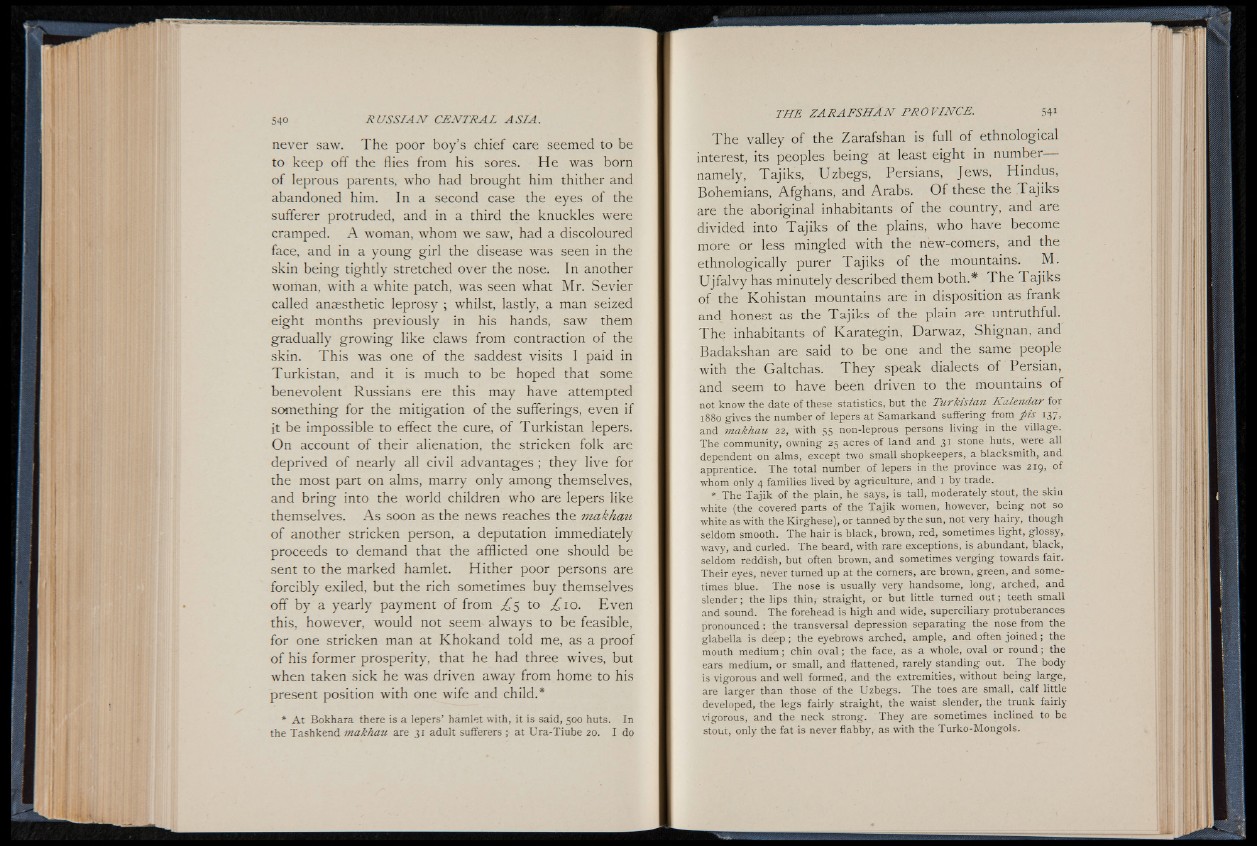
never saw. The poor boy’s chief care seemed to be
to keep off the flies from his sores. He was born
of leprous parents, who had brought him thither and
abandoned him. In a second case the eyes of the
sufferer protruded, and in a third the knuckles were
cramped. A woman, whom we saw, had a discoloured
face, and in a young girl the disease was seen in the
skin being tightly stretched over the nose. In another
woman, with a white patch, was seen what Mr. Sevier
called anaesthetic leprosy ; whilst, lastly, a man seized
eight months previously in his hands, saw them
gradually growing like claws from contraction of the
skin. This was one of the saddest visits I paid in
Turkistan, and it is much to be hoped that some
benevolent Russians ere this may have attempted
something for the mitigation of the sufferings, even if
it be impossible to effect the cure, of Turkistan lepers.
On account of their alienation, the stricken folk are
deprived of nearly all civil advantages ; they live for
the most part on alms, marry only among themselves,
and bring into the world children who are lepers like
themselves. A s soon as the news reaches the makhaii
of another stricken person, a deputation immediately
proceeds to demand that the afflicted one should be
sent to the marked hamlet. Hither poor persons are
forcibly exiled, but the rich sometimes buy themselves
off by a yearly payment of from ^5 to £10. Even
this, however, would not seem always to be feasible,
for one stricken man at Khokand told me, as a proof
of his former prosperity, that he had three wives, but
when taken sick he was driven away from home to his
present position with one wife and child.*
* A t Bokhara there is a lepers’ hamlet with, it is said, 500 huts. In
the Tashkend makhau are 31 adult sufferers ; at Ura-Tiube 20. I do
The valley of the Zarafshan is full of ethnological
interest, its peoples, being at least eight in number
namely, Tajiks, Uzbegs, Persians, Jews, Hindus,
Bohemians, Afghans, and Arabs. O f these the Tajiks
are the aboriginal inhabitants of the country, and are
divided into Tajiks of the plains, who have become
more or less mingled with the new-comers, and the
ethnologically purer Tajiks of the mountains. M.
Ujfalvy has minutely described them both.* The Tajiks
of the Kohistan mountains are in disposition as frank
and honest as the Tajiks of the plain are untruthful.
The inhabitants of Karategin, Darwaz, Shignan, and
Badakshan are said to be one and the same people
with the Galtchas. They speak dialects of Persian,
and seem to have been driven to the mountains of
not know the date of these statistics, but the Turkistan Kalendar for
1880 gives the number of lepers at Samarkand suffering from £is 137»
and makhau 22, with 55 non-leprous persons living in the village.
The community, owning 25 acres of land and 31 stone huts, were all
dependent on alms, except two small shopkeepers, a blacksmith, and
apprentice. The total number of lepers in the province was 219, of
whom only 4 families lived by agriculture, and 1 by trade.
» The T ajik of the plain, he says, is tall, moderately stout, the skin
white (the covered parts of the Tajik women, however, being not so
white as with the K irghese), or tanned by the sun, not very hairy, though
seldom smooth. The hair is black, brown, red, sometimes light, glossy,
wavy, and curled. The beard, with rare exceptions, is abundant, black,
seldom reddish, but often brown, and sometimes verging towards fair.
Their eyes, never turned up at the corners, are brown, green, and somer
times blue. The nose is usually very handsome, long, arched, and
slender; the lips thin,- straight, or but little turned o u t; teeth small
and sound. The forehead is high and wide, superciliary protuberances
pronounced ; the transversal depression separating the nose from the
glabella is d e ep ; the eyebrows arched, ample, and often jo in e d ; the
mouth medium; chin o v a l; the face, as a whole, oval or round; the
ears medium, or small, and flattened, rarely standing out. The body
is vigorous and well formed, and the extremities, without being large,
are larger than those of the Uzbegs. The toes are small, ca lf little
developed, the legs fairly straight, the waist slender, the trunk fairly
vigorous, and the neck strong. They are sometimes inclined to be
stout, only the fat is never flabby, as with the Turko-Mongols.